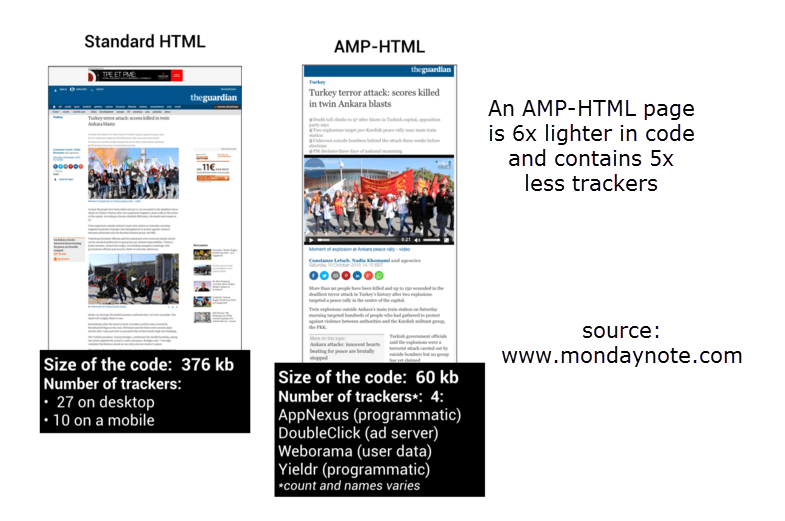Today everyone has the internet in their pocket, but the mobile web is at odds with what users do on the web, which is search and browse. Brands should be keeping up with this user behavior, however many haven’t been and have faced negatives changes in their performance. People bounce. If the page doesn’t load within a couple of seconds, the user will move onto the next page.
To address the mobile speed issue, Google has collaborated with over 40 publishers and technology companies on what they call the AMP Project.
The Accelerated Mobile Pages Project makes the mobile web faster, with the goal of bringing an instant article experience to the open web. In addition to fast load times, user experience improves significantly as accelerated mobile pages allow mobile users to quickly find information that they are searching for without being bombarded by ads and pop ups.
Google announced that AMP pages will start being integrated into its search engine from February 2016. This increased page speed and higher click-through rate is likely to provide a ranking boost over time.
AMP encompasses two main features: speed and monetization.
1) Speed.
On a smartphone, a single page can take many seconds to load. We know that people just walk away from a service that is too slow. By contrast, AMP mobile pages load instantly. Below is a comparison of The Guardian’s Standard HTML pages and AMP HTML pages (add “/amp” at the end of any Guardian URL to get the accelerated version).

Depending on network conditions and the speed of your smartphone’s processor, the loading time is reduced by up to 80%-90%.
This speed increase is attained by the “amp-html” removing most of the conventional web page payload, keeping only the HTML code directly involved in content rendering (text, images, videos gifs and a few trackers). Advertisements load separately after the editorial content. No more waiting for a promotional video to start playing.
2) Monetization.
The Accelerated Mobile Page project supports monetization objects, such as subscription processes, ad formats or editorial content from social networks. The AMP format will speed up the traditionally slow load times of ads on mobile pages. Although there is limited downside to Accelerated Mobile Pages, the nature of the design is for articles and blogs thereby geared towards only publishers. Websites with objectives other than displaying ads and content will find AMP in its current structure too restrictive. Many sites are reliant on the engagement/interactive elements such as forms and shopping carts that are removed from AMP. The Accelerated Mobile Pages formatting is also complex if you are not a developer. You will also need to create a separate analytics account.
With speed at the forefront, Google announced updates to their mobile-friendliness algorithm too.
Google’s Mobile Update
It has been almost a year since Google released its Mobile-Friendliness Algorithm Update (referred to as “mobilegeddon” by some). Although it didn’t have the monumental impact that was expected, it was the most significant algorithm update since the roll-out of Google Panda in 2011.
This update gave preferential rankings to those sites deemed by Googlebot to be “mobile-friendly” and punished “mobile-unfriendly” sites in Google’s mobile search rankings. In May 2016, Google is expected to release the 2.0 update, further hurting sites that are not deemed mobile-friendly as the effects of that algorithm update will be amplified.
The mobile criteria Google uses includes:
- Fast page speed
- Avoidance of software not common on mobile devices (Flash)
- Links are placed far enough apart to aid tapping
- Use of readable text without zoom
- Content is sized to the screen to eliminate scrolling
With speed continuing to be one of Google’s obsessions, AMP will be added to Googles criteria for mobile-friendly sites. Google does not use AMP as a ranking signal today but it prominently features AMP pages. Odds are over time Google will increase the importance of using AMP and become a ranking factor just like it did with its first efforts in ranking mobile-friendly sites higher.
“Mobilegeddon” as it was coined last year was over hyped and we expect even less of an immediate impact with this update for a few reasons:
- This update will be gradually rolled-out rather than an instant ‘switch on’ of the latest algorithm.
- The mobile friendly algorithm is a page-level signal, not a site-level signal. Changes are likely to take some time to occur.
- Fewer websites will be exposed to the risk. Organizations have had time to optimize their pages for mobile friendly compliance from last year.
As critical as site speed is, it is even more important on mobile. It enhances user experience, conversion rates, and search rankings. Because of this, it is expected that the update will incorporate AMP as a ranking factor in the near future. Although complex and limited to publishers, pages utilizing AMP and cached in Google’s AMP cache will earn higher rankings than other content pages.
Want your site to excel in mobile usability? Contact DAC. We’re the experts in all things digital.




